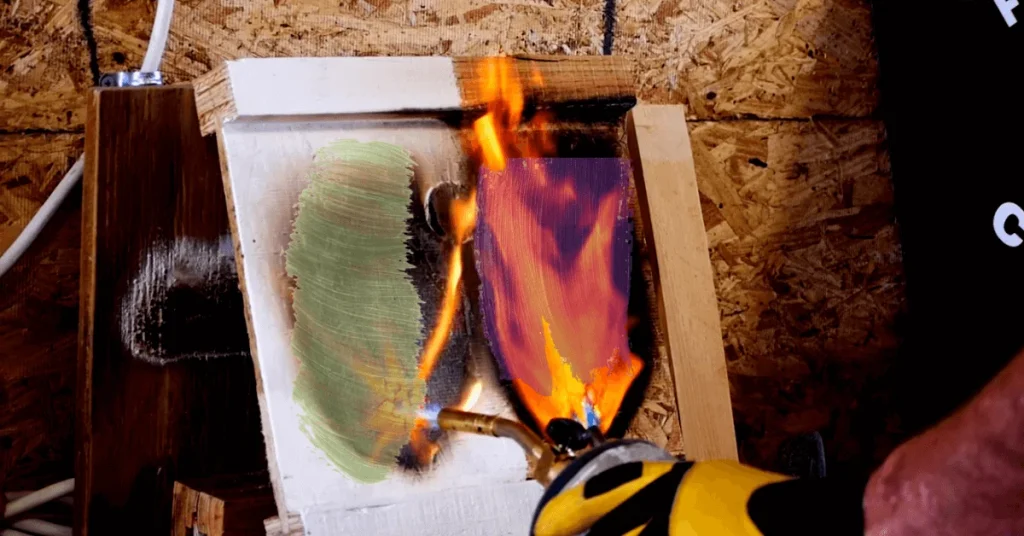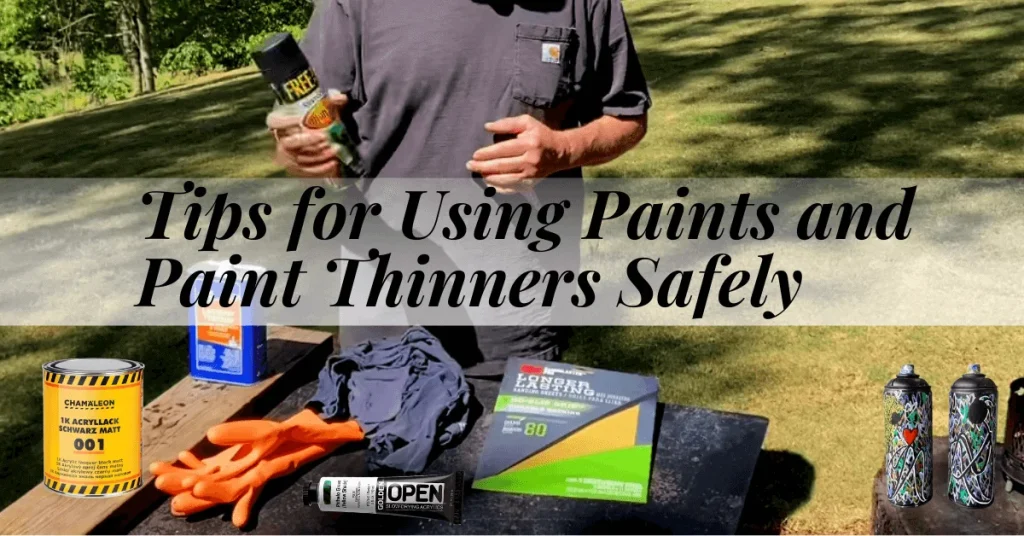Is acrylic paint flammable or combustible? The question has great importance for artists who are fond of using acrylics. The answer to the query is straightforward. Acrylics are combustible.
The reason behind the combustible nature of acrylics is their composition. We know very well acrylics are made up of a polymer known as polymethyl methacrylate. The polymer is utilised to make the paint sticky so that it adheres to the surfaces. But at the same time, it has some disadvantages, too, like combustion.
The polymer releases fumes when heated, causing the paint to catch fire. Some of the paint makers try to use the polymer to a minimum extent.
What Is The Difference Between Flammable And Combustible?
Sometimes both terms are used for the same purpose. But the fact is both are different. Combustible substances can capture fire at higher heat as they release a lower amount of vapours.
On the other hand, flammable are substances that can catch fire even at lower heat because a higher amount of igniting vapours are released by them.
Acrylic paints are considered combustible as they release minor concentrations of vapours and do not necessarily ignite.
No matter what type you’re dealing with, it’s always advised to follow the precautionary instructions to evade any mishap. If you’re dealing with acrylics, choose an airy area and avoid smoking.

Are Paints Flammable?
Paints are flammable, but not all are the same. Some of the paints are designed to be non-flammable, while others are lightly combustible.
Oil-based paints should be used carefully as they are one of the most flammable paints. They can catch fire easily, even at a minor spark.
Water-based paints are lightly flammable as they don’t release many vapours. Most of the vapours consist of water.
Acrylics are in between the above two. They are mildly volatile and catch fire if not handled properly.

Are Latex Paints Flammable?
Are latex paints flammable? The reply is not straightforward, as some factors must be considered. The nature or composition of latex paint gives us an idea.
Latex paints are prepared with water-based wax or resin. The water content of the paint doesn’t allow the paint to be flamed. In simple words, the paint is non-flammable in wet conditions.
Once the water evaporates completely, the paint is readily ignitable. In other words, latex paints are flammable in dry conditions.
Is Acrylic Paint Flammable?
The most straightforward explanation is yes, acrylic paints are flammable. But the severity varies. Not all acrylics have the same formulation. Some may have a higher quantity of volatile solvent while others have smaller. So the ones with higher amounts of solvent are more likely to catch fire quickly.
Moreover, the dry time of acrylics also plays a crucial role. As long as the paint is wet, it will likely get flamed. While in dried condition, the paint is not easy to burn.
One thing should be kept in mind; acrylics are flammable but not explosive. It means you can make the paint get burned without explosion.
Are Acrylic Paints Flammable When They Get Dry?
Acrylic paints are composed of colour pigments mixed with synthetic polymers suspended in water molecules. Once the water is evaporated, it leaves a dry plastic-type paint behind. So yes, acrylics are flammable when they get dry, but as much as other paints.
So be careful even after the paint has dried, as it can catch fire. Make it stay away from flames, smoking, open fire, etc.

Are Acrylic Latex Paints Flammable?
Acrylic latex paint is composed of resin suspended in water molecules. In wet conditions, the paint is not flammable. The reason behind this is the water content in them. But still, they are prone to catch fire.
Acrylic latex paints have wide usage and possess stable features. They are easy to clean after painting and don’t get damaged by spills.
Is Acrylic Enamel Naturally Flammable?
Acrylic enamel is composed of resin which is a polymer and pigment of different colours. It is usually utilised to paint vehicles.
Generally, acrylic enamel is not flammable, but if disclosed to heat more than a limit, it can catch fire. The paint is broken and releases fumes which are responsible for ignition.
Is Liquitex Acrylic Paint Flammable?
One of the most popular acrylic paint is Liquitex. The company claims that the paint is non-flammable and has no toxicity. And it’s somehow true.
But it’s necessary to note that it applies to paint only. Sometimes thinners and solvents are added, which can cause the paint to catch fire.
Even if you’re not adding any solvent or thinner still susceptible to heat when dried. So better to follow preventive measures while handling the paint.
Is Tamiya Acrylic Paint Flammable?
Tamiya is Japenese based company famous for manufacturing model kits, paints, and other art products. The acrylic paint prepared by Tamiya is claimed to be non-flammable and non-toxic by the company.
But keep in mind the paint is susceptible to fire when thinner or solvent is added. So it’s better to be careful while dealing with wet paints.

Are Acrylic Lacquers Flammable?
Lacquer is a synthetic resin used for wood finish. It dries quickly by evaporation. The evaporated substances can be ignited and cause the resin to catch fire.
The lacquer is most widely used to coat painted surfaces or give an enduring finish to art. Be careful while using the resin, as it can catch fire easily.
Are Acrylic Paint Vapours Flammable?
Acrylic paints are not flammable, but the solvents or thinners can catch fire. When the paint is heated, it releases fumes or vapours. These vapours are highly volatile. So we can conclude that acrylics are not usually flammable, but heat can cause them to be combustible.
As a precautionary measure, always try to use the paint in a ventilated area and avoid smoking while painting.
Are Oil Based Paints Flammable?
Yes, oil-based paints are flammable. The reason is they contain volatile compounds. We know very well that oil-based paints are composed of petroleum or other organic compounds, which are highly volatile and catch fire easily.
High volatile organic compounds vaporise even at room temperature. These vapours can easily get ignited. It’s the reason oil-based paints are flammable.
Moreover, oil-based paints are not replaceable as they are suitable for painting wood, cars, metals, etc. But instructions should be strictly followed.
Are Water-Based Paints Flammable?
No water-based paints are non-flammable to some extent as long as you’re not willing to burn them intensional. They are made up of water as a base which makes them non-combustible, but once the water content evaporates, they are susceptible to catching fire.
Are Spray Paints Flammable?
The answer to the question is complicated. Most people believe spray paints are flammable, but it’s not necessary. The organic content of the paint evaporates quickly, which is a combustible part, leaving behind the paint.
The paint is non-flammable. But yes, the gas or organic compound used to thin the paint is flammable.
So be careful while dealing with spray paints. Avoid smoking and use it in a good-ventilated area to avoid mishaps.

Non-Flammable Paints:
Various non-flammable paints are available in the market ranging from water-based paints to some latex dyes and acrylic paints.
Most non-flammable paints are synthesized to withstand ignition and protect the paint from catching fire. Some of the paints come with additional settings or liquids to assure safety.
Flammable paints catch fire due to the volatile vapours. So paint companies tend to minimise the usage of these volatile compounds while manufacturing the paints.
Despite being non-flammable and lacking solvents, the paint doesn’t lose its quality, colour tone, and finishes. The companies never compromise the quality of the paint.
A manual is there for your guidance inside the package. Read the instructions before using the paint.
Is Paint Thinner Flammable?
Thinner is nothing but a petroleum-based chemical utilised to thin the paint and wash the dirt off brushes and hands. As we said, it’s made up of petroleum, so definitely it’s highly flammable.
So make sure to expose the thinner to heat, smoke, or fire to avoid fire. Store the lighter inside a dark place and protect it from direct sunlight.
Tips for Using Paints and Paint Thinners Safely:
As we discussed in detail how much the paints and thinners are flammable, so it’s vital to learn safety measures in order to deal with these compounds. Following are some preventive measures.

Tip 1: Only Blend it with the Paint: A specific paint thinner is designed for a particular paint. So mix them. Never try to mix compounds other than the thinner with paint.
Tip 2: Put them away from the Stove: Paint thinners and paint are flammable compounds. So store them away from direct sunlight and heat sources.
Tip 3: Use Flashlight In Place of Candle: If you’re painting in the dark and need some light, a candle is a wrong choice as it can cause the compounds to catch fire, use a flashlight instead.
Tip 4: Avoid Smoking: Some painters smoke while painting. It’s a bad idea. You’re dealing with flammable compounds, so avoid smoking.
Tip 5: Store them Properly: Make sure the acrylic paint storage is well-protected and away from heat, sunlight, and moisture. Sealed containers are a better choice to avoid evaporation.
Tip 6: Personal Safety Equipment: Personal health should be the priority. Use safety equipment like goggles, gloves, and masks while painting. It will protect you from direct contact with flammable compounds.
Tip 7: Put Fire Extinguisher Near You: A fire extinguisher should be kept nearby as any misfortune can happen. Please read the manual of the extinguisher to learn using it.
Tip 8: Ventilation: Ventilation is crucial while painting as the vapours need to be expelled. Using a fan or painting near a window is a better choice.
Tip 9: Dispose of them Properly: Paint and paint thinner should be disposed of properly. A separate basket should be used for these flammable compounds.
Risks of Flammable and Combustible Paints You Must Know
Risks associated with flammable and combustible paints include health problems, toxicity, fire, and even explosions. So it’s crucial to use these paints professionally.
Inhaling toxic fumes or vapours can cause severe health problems and damage the lungs directly along with other organs. So use a mask while painting with such combustible paints.
The second disadvantage is ignition and fire. If used without safety, they can catch fire easily and damage the surroundings. If the vapours are collected inside a closed room, an explosion is possible.
How Can You Dispose of Paint?
After you’re done with your painting task, you may be fled with some extra paints behind. You would like to dispose of the paint or get rid of it.
The better way is to donate the paint to someone looking for them. Or give to the recycling factories.
If you’re going to throw it out, be a responsible citizen and avoid making it harmful to others. Latex paint should be dried out before you throw them into the trash. Remove the lid and let the airflow dry the paint. Once the paint is hard enough and all the volatile substances are lost, it’s ready to go to the basket.
Oil-based paints should be disposed of away from the population as it’s toxic to humans and animals as well.
FAQs:
What happens if acrylic paint gets heated up?
Heat makes acrylics hazardous for humans and animals. Although there are many debates on acrylic paint’s heat resistance but in wet conditions, the heat will make the paint release toxic substances which cause eyes, nose, and respiratory disorders. In dry conditions, acrylics are more likely to catch fire and still dangerous to health.
Can you paint a candle using acrylic paint?
It’s a bad idea to paint the candle with acrylics. The paint has flammable substances and catches fire when exposed to heat or direct flames. Better to paint the candle when it’s not ignited.
What type of paint is flammable?
Most paints are flammable due to the thinners we mix in them. Latex paint, enamels, and oil-based paints are susceptible to fire. Whatever paint you choose, read the instructions or preventive measures that come along with the paint. Store them in a favourable environment.
Can acrylic dyes be put in the oven?
Yes, acrylics can be put in the oven, but be careful the thinner should not be applied while heating the paint as thinners are primarily organic compounds and catch fire easily.
Is it safe to use acrylic paint near heat sources?
It is generally not recommended to use acrylic paint near heat sources due to the risk of fire. Exercise caution and avoid exposing acrylic paint to direct heat or flames during use.
Conclusion:
Acrylics can catch fire if not handled with care and cause damage if preventive measures are not followed. But some of the tips given in the article can broaden your knowledge about the handling of different kinds of paints, mainly acrylics.
Thank you for reading. Please comment below for queries, suggestions, or appreciation.
- How To Buff Acrylic Enamel Paint In 5 Easy Steps? - February 2, 2024
- How To Make Acrylic Paint More Opaque? 10 Effective Methods - February 1, 2024
- How To Sketch On Canvas Before Acrylic Painting? Draw Like a Pro - January 31, 2024

